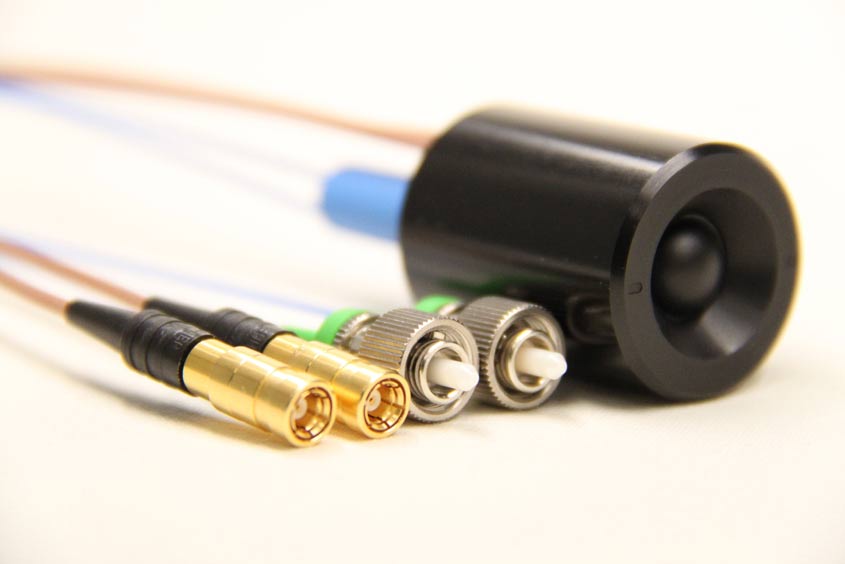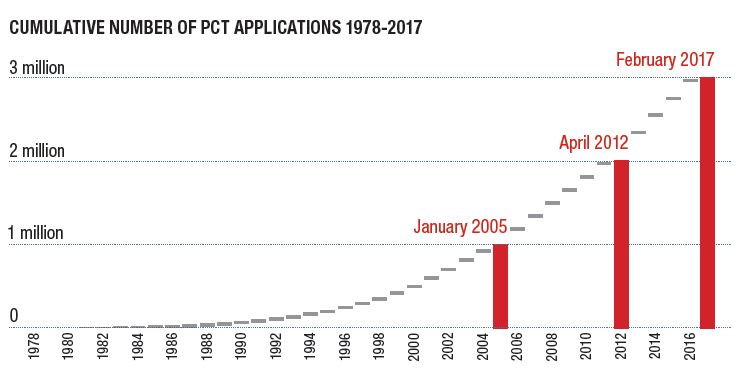
WIPO’s PCT publishes 3 millionth international patent application
By Catherine Jewell, Communications Division, WIPO
In February 2017, WIPO published the 3 millionth international application under its Patent Cooperation Treaty (PCT). This milestone in the history of the international patent system and WIPO is yet another indication that, amid a great deal of economic uncertainty, the global knowledge economy is thriving.
Since the PCT became operational in 1978, it has enjoyed remarkable growth. It took 26 years to reach one million international applications in late 2004, but less than 12 years to reach the three million mark. Apart from a blip in 2009 – the only year in which filings fell – PCT use has grown every year. In 2015, a record 218,000 international applications were filed under the system, with provisional figures for 2016 showing another year of strong growth.

About the 3 millionth published international application
The 3 millionth international application published on February 2, 2017, was filed by Germany’s Fraunhofer Gesellschaft zur Förderung der angewandten Forschung e.V. (Fraunhofer), one of the world’s leading international applied research organizations. Fraunhofer is a major user of the PCT, averaging almost 300 international applications under the PCT over the last five years. The invention described in the application (WO/2017/017579), developed by the Fraunhofer Institute for Telecommunications, Heinrich Hertz Institute, HHI, one of Fraunhofer’s 69 institutes across Germany, combines Fraunhofer HHI’s expertise in two areas, namely terahertz radiation, which is a powerful imaging technology, and high-speed electronic data transmission. The invention, known as a “Vector Network Analyzer”, is an innovative terahertz measuring system that packages the transmitting and receiving units for terahertz radiation into a tiny sensor head measuring just 25 mm by 35 mm. The invention has practical applications in materials testing and components inspection. While terahertz technology has been around for some time, for many years it was considered too expensive, bulky and difficult to use. Fraunhofer HHI’s invention promises to change this and to give “terahertz technology a decisive boost”. Made from standard, low-cost components, it makes it much cheaper and easier to test the viability of materials and components, such as plastic tubes.

What the PCT does
Companies and inventors like Fraunhofer use the PCT because it makes it easier and more cost-effective for them to seek patent protection for their inventions in international markets. By the end of January 2017, 151 countries had signed up to it. A single international patent application under the PCT System has legal effect in all the other countries bound by the Treaty.
It offers users a number of advantages. In particular, they can postpone the significant costs associated with obtaining patent protection in multiple jurisdictions by up to 18 months. Under the traditional patent system, the so-called “Paris route”, all relevant documents and fees are payable on the day a patent application is filed with a national office. By contrast, PCT users can benefit from valuable feedback about the potential patentability of their invention before deciding whether to continue pursuing patent protection – and pay the relevant fees – in their chosen PCT countries. This additional time and feedback creates opportunities for applicants to test the market for their invention and, if necessary, find new business partners. It also offers national patent offices a number of advantages, particularly in terms of simplifying procedures and streamlining workflow.
Fraunhofer’s take on the PCT
“The PCT is an excellent way of creating intellectual property rights, in particular in cases where time is needed for strategic and cost-relevant decisions,” notes Professor Alexander Kurz, Executive Vice President of Human Resources, Legal Affairs and IP Management at Fraunhofer. “The filing of a PCT application allows Fraunhofer to preserve its rights worldwide prior to identifying commercial partners and developing commercialization strategies for its inventions. A PCT application brings a large part of the world within reach without the need to file applications directly with individual countries, and allows us to postpone the major payments associated with internationalizing patent applications. But it also ensures that information about the value of the application is available at a relatively early stage. In summary, the PCT provides additional time for us to find the optimal partner and the most appropriate market for our inventions. In addition, relevant information about the patentability of a given application may be considered at an early stage.”
The PCT has reached three million applications in record time, underscoring the central importance of the system and its role in helping innovators reach global markets.
WIPO Director General Francis Gurry
Patent information and the PCT
When companies and inventors embark on the process of obtaining a patent for their inventions, they are required to describe in detail what it is they claim to have invented. This information serves as the basis on which patent examiners in national offices decide whether an application meets the criteria for patentability as set out in national patent laws (i.e., novelty, inventive step or non-obviousness, and applicability). At a certain point in the process – both for applications submitted via the PCT and those made directly at national offices – the application is published and available for anyone to consult.
Patent applications contain a huge amount of technological information that is often not published anywhere else, making them an extremely valuable source of information. As such, every patent application that is published expands the amount of technical knowledge that is publicly available – the aim here is to inspire further innovations. These data, which also contain a great deal of business intelligence, are made available free of charge through public databases such as WIPO’s PATENTSCOPE. With more than 50 million patent applications, PATENTSCOPE is one of the world’s largest publicly available patent databases.
Notable inventions that have passed through the PCT
For nearly 40 years, the PCT has helped individual inventors, some of the world’s largest companies, as well as universities and research institutions (like Fraunhofer) to protect their innovations in international markets. While inventors cannot know the commercial value of their inventions when they apply for a patent – they will not have entered the market at that stage – a brief search through PATENTSCOPE shows examples of inventions in many sectors that have gone on to enjoy huge commercial success.
Web technologies
International applications in the area of web technologies include applications filed by some of the biggest names in the online world, from Facebook (WO/2007/070676) to Google (WO/2004/008285), and from Ebay (WO/2000/025218) to Skype (WO/2005/009019).
Consumer goods
Many of the technologies that make up our everyday digital reality have passed through the PCT, including the iPod (WO/2006/073891), Apple’s wireless headphones (WO/2015/164287), early forms of word-processing (WO/1989/011695) and email (WO/1989/11695) as well as voice recognition (WO/1994/016435) and bluetooth technologies (WO/1999/014897).
Clean energy
With growing interest in the development of alternative sources of clean energy, inventors have also sought to protect technologies in the areas of biofuels (WO/1994/010107), wind turbines (WO/1980/002056) and photovoltaic solar energy (WO/1982/003728) in international markets through the PCT.

Health
Wide-ranging and potentially revolutionary medical technologies have also gone through the System. These include:
- medical resonance imaging (WO/1998/013821), better known as MRI – for detailed images of the body, and very useful in confirming patient diagnoses;
- magnetic nanoparticle imaging (WO/2016/156340), a new medical technology developed by researchers at Philips Research Laboratory which produces real-time 3D images of soft tissue for use in detecting and diagnosing cancers and cardiovascular disease;
- CRISPR (clustered regularly interspaced short palindromic repeats) (WO/2013/176772), a revolutionary gene-editing tool with huge potential to prevent many life-threatening diseases;
- bionic contact lenses (WO/2012/006691) which can be implanted into a human eye to restore or improve the quality of vision. The invention also includes a self-adapting system that allows the eye to achieve automatic sharp vision at distances from 25 cm to 10+ meters, and could make glasses a thing of the past;
- an artificial heart (WO/2007/038463), the AbioCorTM, by ABIOMED Inc. and its collaborators in the USA, is “the first completely self-contained total artificial heart”; intended for use in patients with end-stage heart failure, it was first implanted in a patient in July 2001;
- an anti-HIV vaccine (WO/2001/047955) developed by the Kenya AIDS Vaccine Initiative (KAVI) and its partners to prevent HIV infection and AIDS;
- an artificial pancreas (WO/2000/074753) which allows insulin to be infused into the body continuously in response to glucose rates using a closed-loop system. The device offers patients greater control of their diabetic condition. According to the World Health Organization (WHO), diabetes is a leading cause of death in the world, with some 422 million adults living with the condition.
Business
Technologies that have transformed business processes and created opportunities for business development have also made their way through the PCT, from optical data-sensing systems such as bar codes and scanners (WO/1980/000628) to GPS systems (WO/2006/110805) and liquid crystals for display devices (WO/1979/001025).
And some international patent applications give a flavor of things to come. These include:
- Airbus’s “ultra-rapid air vehicle” (WO/2011/076706), which it claims will travel at four times the speed of sound (Mach 4 to Mach 4.5);
- blockchain technology (WO/2007/118829), a tamper-proof data system that is creating quite a buzz in the fintech sector;
- 3D-printing (WO1994/019112), which has significant potential to transform how and where products are made.
And for those with a taste for space travel, there is even a winged spacecraft (WO/2004/092013)!
The WIPO Magazine is intended to help broaden public understanding of intellectual property and of WIPO’s work, and is not an official document of WIPO. The designations employed and the presentation of material throughout this publication do not imply the expression of any opinion whatsoever on the part of WIPO concerning the legal status of any country, territory or area or of its authorities, or concerning the delimitation of its frontiers or boundaries. This publication is not intended to reflect the views of the Member States or the WIPO Secretariat. The mention of specific companies or products of manufacturers does not imply that they are endorsed or recommended by WIPO in preference to others of a similar nature that are not mentioned.